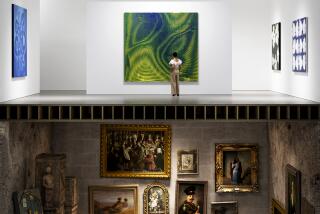Paris’ newest museum a dialogue of cultures
- Share via
Paris
It was a cement-gray Paris morning when we got off the Métro at Alma-Marceau on our way to visit the Musée du Quai Branly, the newest museum in a city teeming with them. After 11 years and more than $290 million, this showcase for the indigenous arts of Africa, Asia, Oceania and the Americas was finally open.
After a quick look at the memorial to Princess Diana (a garish gold replica of the Statue of Liberty’s flame; she died in the underpass beneath the statue), we followed the crowd from the Métro stop across the Seine on Pont de l’Alma, the bridge named for a French battle, to the museum, which opened last year.
With the river on the right and the Eiffel Tower ahead, the museum’s great location, on the last large land parcel in Paris, was assured.
My first impression of the four exterior buildings was their size: a main 600-foot-long building atop stilts and paralleling the Seine, with 30 multicolored boxes protruding from it. Below it is 18,000 square feet of garden designed by Giles Clement. This park of 15,000 plants and winding pathways softens the weighty buildings and adds an indoor-outdoor feel to the museum.
Plants are so important to the design that bamboo is used in some spots instead of louvered windows for light control. That the Branly’s architect, Jean Nouvel, could have a large museum and a large public park at the same time is quite a feat.
The museum was controversial from the outset. Some have deemed the pieces plunder from France’s colonial past. Others think these objects are as important as the art in the Louvre and that they should be given equal importance in a museum.
We entered the museum into an atrium so high that the 46-foot Native American totem pole from British Columbia seemed small. From there we followed a glassed-in spiral walkway reminiscent of Frank Lloyd Wright’s Guggenheim Museum in New York City to view musical instruments from four continents. Who knew there could be so many different types of drums, let alone string instruments and woodwinds, all intricately carved and decorated?
The Branly’s collection numbers around 300,000 objects, including clan headdresses from Alaska, statues from Nigeria, sculptures from Mexico and chest ornaments from India. “Objects” is the term often used for collections like the Branly’s because it signals that these were not art pieces per se but originally had utilitarian or sacred purposes.
On permanent display from this collection are 3,500 pieces that the museum considers the most important. The artifacts are displayed in the long gallery we had seen from outside. The idea behind displaying all the objects together was to allow for an easy comparison between different cultures and time periods.
When we visited, it was sometimes difficult to see the pieces clearly because of poor lighting, and it was easy to get lost. Extra lighting and signage have been added, said Stephane Martin, museum president. Information placards have also been added to identify the geographic origins of the pieces.
The light in certain sections must be kept low “to preserve the objects, especially those made of feathers or fragile textiles,” he said.
With all these objects, does the Branly have a Mona Lisa? “Yes, it is the Djennenke statue,” Martin said. “This pre-Dogon statue from Mali dates back to the 10th or 11th century and is the oldest wood artifact of the African collection. It is one of our most valuable pieces.”
Besides the long gallery, there are small exhibitions in each of the 30 suspended colored boxes clinging to the building’s exterior. The boxes are another way of showing objects and are near each country’s pieces. In front of East Africa is a box with three paintings from Ethiopia mixing African style and Catholic style; the box in front of Siberia holds one shaman costume and two films showing rituals. Some boxes are big, like the one dedicated to Burkina Faso’s masks; others are quite small and can’t be entered.
Half the space at the museum is given to permanent exhibitions and half to temporary ones. Here through Sept. 16 is “Wounded Objects: Repair in Africa.”
Besides the exhibitions, the Branly is a cultural center with a theater for contemporary performances and concerts. There is also a bookstore, a casual restaurant that looks out over the gardens and Eiffel Tower and a rooftop restaurant.
More to Read
Sign up for The Wild
We’ll help you find the best places to hike, bike and run, as well as the perfect silent spots for meditation and yoga.
You may occasionally receive promotional content from the Los Angeles Times.






